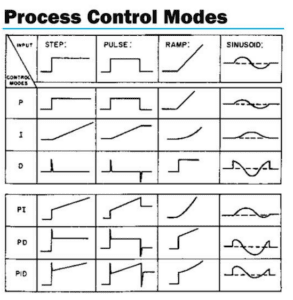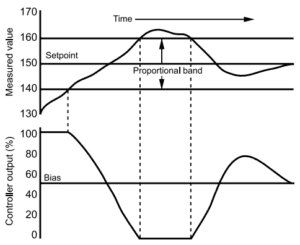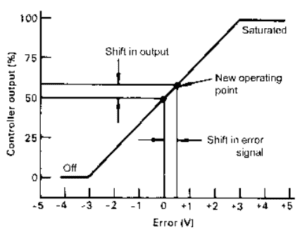 Most industrial processes require that certain variables such as temperature, flow, level or pressure, remain at or near some reference value (setpoint). Closed-loop control is used to achieve this. The process controller looks at a signal representing the process value, compares it to the desired setpoint and acts on the process to minimize the difference (error). The method used by the controller to correct the error is the control mode. The four most popular control modes are on/off, proportional, integral and derivative.
Most industrial processes require that certain variables such as temperature, flow, level or pressure, remain at or near some reference value (setpoint). Closed-loop control is used to achieve this. The process controller looks at a signal representing the process value, compares it to the desired setpoint and acts on the process to minimize the difference (error). The method used by the controller to correct the error is the control mode. The four most popular control modes are on/off, proportional, integral and derivative.
Control Modes
On /off control activates an output until the measured value reaches the reference value. A common example is the household thermostat. No control action takes place until the measured value deviates from the setpoint by a minimum amount (deadband). The output then goes from full off to full-on, turning off again when the setpoint is reached. While simple and low cost, this mode of control has a tendency to overshoot the desired value. A digital panel meter with relay output and adjustable setpoint can be used for on-off process control.
A more refined control method is proportional control. Here the difference between the setpoint and measured value generates a continuous, linear control output. The control gain K sets the system response as a function of time:
Output(t) = K • [Setpoint – Measured(t)] + Bias.
The bias term creates a non-zero output when the error term is driven to zero. This allows bi-directional control. The proportional band is the span of the measured variable that causes a full-range output.
 The higher the gain, the more the output will change for a given change in measurement or setpoint. High K (narrowband) provides more precise control but can create stability problems. Low K (wideband) controls over a wider input span but may be slower to respond. In proportional control, if system loading requires a shift in operating point, a difference between the measurement and setpoint will exist at equilibrium. The higher the system gain, the lower the offset will be for a given load change.
The higher the gain, the more the output will change for a given change in measurement or setpoint. High K (narrowband) provides more precise control but can create stability problems. Low K (wideband) controls over a wider input span but may be slower to respond. In proportional control, if system loading requires a shift in operating point, a difference between the measurement and setpoint will exist at equilibrium. The higher the system gain, the lower the offset will be for a given load change.
 Controllers with reset (integral) action will automatically recenter the proportional band around the offset bias level. An integral mode controller responds to the integral of the difference between the setpoint and measured value. The adjustable parameter for integral control is the integral time T, or the reset rate 1/T. The integral mode is sometimes used as a single mode of control but is more commonly used with proportional control. This is known as two-mode PI control. In processes requiring relatively low gain, the integral mode continues to drive the output even when the proportional error is zero. This combination generates a smaller total error than either mode operating alone.
Controllers with reset (integral) action will automatically recenter the proportional band around the offset bias level. An integral mode controller responds to the integral of the difference between the setpoint and measured value. The adjustable parameter for integral control is the integral time T, or the reset rate 1/T. The integral mode is sometimes used as a single mode of control but is more commonly used with proportional control. This is known as two-mode PI control. In processes requiring relatively low gain, the integral mode continues to drive the output even when the proportional error is zero. This combination generates a smaller total error than either mode operating alone.
The derivative mode is commonly called rate control because its output is based on the rate of change of the measured variable. This mode is rarely used alone. It is typically combined with proportional control to form PD control or with proportional and integral control in a three-mode PID controller. The derivative term anticipates changes to reduce overshoot. A variant of the derivative mode uses the derivative of the measured variable rather than the derivative of the difference signal. This can speed response to large process shifts but slows the response to a setpoint change.
Although most PID controllers use proportional outputs, PID control can also be used with on/off outputs by incorporating duty cycle modulation. For each time interval (cycle time), the controller adjusts the on-time in response to the control signal magnitude. Since this generates frequent on/off operations, solid-state outputs are recommended over mechanical relays.
Non-linear controllers may be preferred for processes that are highly non-linear, such as pH. The standard control modes of proportional, integral and derivative are superimposed on a non-linear function. Non-linear controllers can also be used to filter noise or pulsations while permitting effective control over large disturbances.
A single loop controller handles one process input. Multi-loop controllers can simultaneously control more than one process variable. Controllers with digital communication capability are often called distributed controllers. Some controllers can also retransmit the process variable or error signal in analog form for display on a remote indicator.
Tuning
Tuning is a critical but often confusing aspect of proper controller application. Many reference books and on-line forums are dedicated to tuning issues. Tuning can be optimized for load changes, setpoint changes or other factors. Open-loop tuning involves breaking the feedback path and characterizing the system response. Closed-loop characterization can be done with the feedback loop intact, by introducing a known disturbance and monitoring the response. The controller can then be manually adjusted for the signal ranges, time constants and delays of the process. This can be a complex and lengthy task. Fortunately, controllers often include automatic tuning capabilities to learn a process and set the appropriate control loop parameters.
Signal Conditioning
Many process controllers can be connected directly to the process sensor, such as a thermocouple or RTD. In some cases, an additional transducer or signal conditioner is required to convert the physical parameter to an electrical signal that can be handled by the controller. Many of the new ‘smart’ sensors include this signal conditioning, eliminating the need for an additional module. Transducers are also needed to convert some electrical parameters, such as AC power, into a signal compatible with the controller’s input.
